- Clinical Technology
- Adult Immunization
- Hepatology
- Pediatric Immunization
- Screening
- Psychiatry
- Allergy
- Women's Health
- Cardiology
- Pediatrics
- Dermatology
- Endocrinology
- Pain Management
- Gastroenterology
- Infectious Disease
- Obesity Medicine
- Rheumatology
- Nephrology
- Neurology
- Pulmonology
Skin Disorders: 5 Shots, 5 Tips (Series #2)
Here: Ted Rosen, MD, presents 5 tips about 5 skin disorders that you might not know.
Case 1
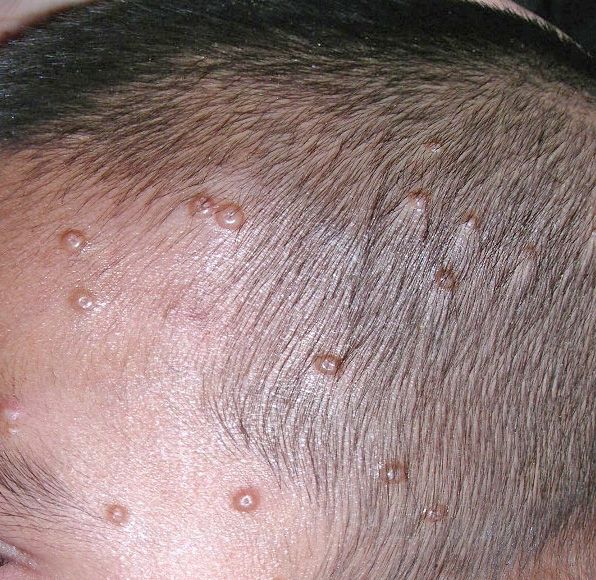
A 5-year-old boy presents with multiple, asymptomatic facial “bumps” of recent onset.
Key point: The globoid-shaped papules with central umbilication are typical for molluscum contagiosum, a pox virus infection spread by skin-to-skin contact.
Treatment: Sharp curettage removes lesions nicely. Light liquid nitrogen cryospray may also be effective in some patients. When surgical intervention is impractical, topical application of various irritants (such a tretinoin or salicylic acid) or immune modifiers (such as imiquimod) may be effective.
Note: The same disorder may occur in adults, usually in the genital region, as a sexually transmitted disease. Treatment options are the same.
Case 2
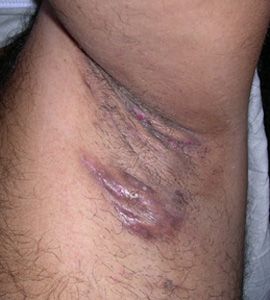
A 28-year-old man presents with “never-ending boils” under both arms and, occasionally, in the groin. Repeated courses of antibiotics have failed to resolve this problem.
Key point: Recurrent or persistent eruptions of boil-like inflammatory nodules in areas rich in apocrine sweat glands is characteristic for hidradenitis suppurativa.
Treatment: Because this is NOT an infection, antibiotics usually do not work well. Surgical removal of involved skin and subcutaneous tissue, when feasible, is the treatment of choice. If that fails, various biologic drugs have proved beneficial in off-label use.
Note: Invasive squamous cell carcinoma may eventually develop within chronic hidradenitis.
Case 3
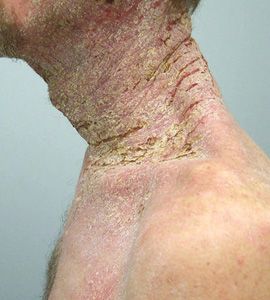
A 38-year-old HIV-positive man presents with an intensely itchy eruption involving the neck and upper torso.
Key point: The thickly scaling skin, along with intense itching, especially in an immunocompromised patient, strongly suggests crusted scabies.
Treatment: The optimum therapy is uncertain, but most practitioners combine multiple doses of oral ivermectin with topical permethrin in an extended course.
Note: Crusted (or Norwegian) scabies can be considered an emergency. The fissures that accompany this disease (depicted here) act as a portal of entry for bacteria and may lead to sepsis.
Case 4
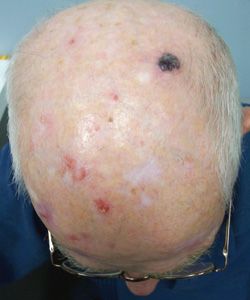
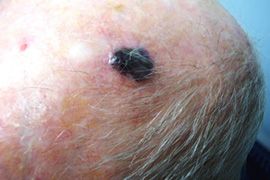
A 78-year-old man with many past skin cancers presents with a hard, slightly tender, dark-colored nodule on the scalp.
Key point: His prior history of cutaneous neoplasia should heighten suspicion that this lesion is also cancerous. Malignant melanoma, suspected because of the black color, was proved by biopsy.
Treatment: The lesion was excised with a wide margin. Sentinel lymph nodes were determined and found to be free of macro or micro metastases. An additional workup for visceral metastatic disease was negative. Because of the thickness of the primary lesion, adjunctive biochemotherapy was recommended.
Note: Treatment of melanoma is determined by results of staging investigations, including the thickness of the primary lesion.
Case 5
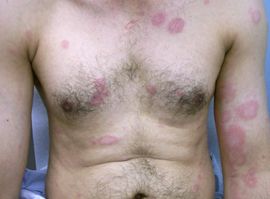
A recent immigrant from India presents with a widespread eruption consisting of circular, non-itchy, non-painful plaques on the torso and upper extremities. The patient noted that each lesion felt “numb.”
Key point: Always consider residential and travel history. In this case, the native of India demonstrates classic anesthetic lesions of Hansen disease (leprosy).
Treatment: The patient was referred to a public health clinic specializing in the treatment of Hansen disease. His medications included dapsone and rifampin.
Note: Hansen disease can also be acquired by natives of the United States, especially when they have close contact with 9-banded armadillos.
